Introduction
Michael Faraday was born on 22 September 1991 in Newington Butts, a place called Surrey. Faraday was a chemist and a physicist whose various experiments significantly contributed to the knowledge of electromagnetism (Cantor, 2016). Faraday was one of the most prominent scientists of the 19th century and began his career as a chemist (Krawczyk, & Korzeniewska, 2017). He discovered new organic compounds, including benzene, and wrote a manual of various chemistry practical; Faraday was also the first scientist to liquefy a stable gas. However, Faraday's significant contributions were in the field of magnetism and electricity, being the first scientist to develop an electric current from a magnetic field (Clark, 2018). He later invented the first dynamo and electric motor and explored the effect of magnetism on the light; he also illustrated the relation between chemical bonding and electricity. Faraday is remembered as a great scientist who invented and named diamagnetism, the unique behavior of certain materials in powerful magnetic fields (Cantor, 2016). Faraday's contribution to the field of electromagnetism was his presentation of an excellent theoretical and experimental deal that helped constitute the basis upon which James Clerk Maxwell got and came up with the classical theory of the electromagnetic field. This paper presents a biography of Michael Faraday, one of the most renowned scientists in the 19th century.
Michael Faraday Early Life and Education
Michael Faraday was born in Newington, a country village in Surrey, currently a part of South London. Faraday's father was called James and was a blacksmith who had migrated earlier in 1791 from the north of England to Surrey in search of work (Krawczyk, & Korzeniewska, 2017). The mother was a countrywoman of dignified calm and wisdom; Faraday's mother supported him emotionally through a challenging or difficult childhood. The family had four children; however, it was a humble family with a father often ill and incompetent of working steadily; thus, he could not provide for all the family needs, including educating the children.
Faraday only acquired the rudiments of education; he learned to cipher, read, and write, in a church Sunday school. He started to deliver newspapers for a bookbinder and book dealer at an early age to earn money and was later apprenticed to the man at the age of 14 (Krawczyk, & Korzeniewska, 2017). Faraday used the opportunity to read various books brought in for rebinding and was particularly fascinated by Encyclopædia Britannica, an article on electricity and the third edition. Using lumber and old bottles, Faraday made a crude electrostatic generator, did simplistic experiments, and developed a weak voltaic pile with which he performed electrochemistry experiments.
Faraday got a job as a laboratory assistant at the Royal Institution in 1813; Faraday toured France, Southern Germany, Switzerland, Italy, and France with Humphry Davy between 1813 and 1815. He later married Sarah Barnard on 12 June 1821; however, the couple never had children (Cantor, 2016). He was presented with a great opportunity by Sir Humphry Davy, who offered him a ticket to attend chemical lectures at the Royal Institution of Great Britain in London. Faraday started to work with Sir Charles Wheatstone on the theory of sound, another vibrational aspect. In late 1831, Faraday attempted to discover how an induced current was produced. His first experiment involved a powerful electromagnetic generated by the winding of the primary coil. He later tried to create a current by using a permanent magnet; he discovered that a current was induced in the coil when a permanent magnet was moved in and out of a coil of wire (Clark, 2018).
Faraday Later Life
The year that Faraday got married was the same year he invented electromagnetic rotation. He later found electromagnetic induction in 1831; electromagnetic induction is the principle behind the electricity generator (Krawczyk, & Korzeniewska, 2017). When he was made the director of the laboratory at the Royal Institution in 1825, Faraday proved to be an accomplished chemist by isolating benzene; he became a professor of chemistry at the Royal Military Academy in Woolwich between 1830 and 1852 and became a scientific adviser to Trinity House in 1836 (Bagnoli, & Livi, 2018).
In 1846, he was still a lecture at the Royal Institution scheduled to deliver one of the Friday evening speeches, where he encouraged the popularization of science (Krawczyk, & Korzeniewska, 2017).
Michael Faraday was a devoted member of the Sandemanian Church; the church was founded in the 18th century in Scotland. Michael Faraday died at the age of 75 on 25 August 1867 and was buried in Highgate Cemetery (Bagnoli, & Livi, 2018). Today Faraday is commemorated as a great physicist and chemist and one of the explorers of the use of electricity (Krawczyk, & Korzeniewska, 2017).
References
Cantor, G. (2016). Michael Faraday: Sandemanian and scientist: a study of science and religion in the nineteenth century. Springer. https://www.palgrave.com/gp/book/9780333588024
Bagnoli, F., & Livi, R. (2018). Michael Faraday: a virtuous life dedicated to science. Substantia, 2(1), 121-134. https://riviste.fupress.net/index.php/subs/article/view/45
Clark, E. (2018). Pioneers in optics: Michael Faraday. Microscopy Today, 26(2), 50-51. https://www.cambridge.org/core/journals/microscopy-today/article/pioneers-in-optics-michael-faraday/8B6573B4BE75E7EE44FAD4D2A70E228C
Krawczyk, A., & Korzeniewska, E. (2017, September). Life and discoveries of Michael Faraday (to commerate 150 th anniversary of his death). In 2017 18th International Symposium on Electromagnetic Fields in Mechatronics, Electrical and Electronic Engineering (ISEF) Book of Abstracts (pp. 1-2). IEEE https://ieeexplore.ieee.org/abstract/document/8090664/
Cite this page
Essay Example on Michael Faraday: 19th Century Chemist & Physicist. (2023, Aug 08). Retrieved from https://proessays.net/essays/essay-example-on-michael-faraday-19th-century-chemist-physicist
If you are the original author of this essay and no longer wish to have it published on the ProEssays website, please click below to request its removal:
- Conflict and Compromise With Segregation Essay
- Abraham Lincoln's Biography
- Essay Sample on Vernacular Music of the United States
- Essay on Life After Slavery: End of Injustices & Brutality in the South
- Essay Sample on Stono Rebellion: African Slaves' Uprising of 1739 in South Carolina
- Formation of Caves: Exploring Limestone Dissolution - Essay Sample
- Iraq and Syria: The Aftermath of Bush's Choices - Essay Sample







